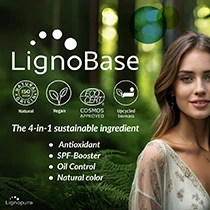Croda’s Phytessence Osmanthus: Geo-skin care innovation for climate-resilient protection
11 Mar 2024 --- Croda launches Phytessence Osmanthus, a geo-skin care ingredient it claims combats climate change-related issues such as heat, pollutants and extreme weather.
Personal Care Insights connects with Robin Cordier, Croda’s botanicals digital and communication coordinator, who sheds light on the inspiration behind the innovation.
He also addresses how osmanthus flowers influenced product development and the company’s sustainability initiatives with Eco-Sound technology.
What inspired Croda to create Phytessence Osmanthus, and how does it stand out in geo-skin care?
Cordier: When we set out to create a product, we always seek innovations that provide a natural and effective response to a global market issue, a fundamental beauty trend or a promising emerging concept. Phytessence Osmanthus response to thermal shock.
Phytessence Osmanthus response to thermal shock.
For Phytessence Osmanthus, the geo-skin care trend stood out as a real opportunity for creating something new, but it is still applicable worldwide. There’s no denying that climate change is a major concern, wherever we are or whatever we do. Weather conditions are becoming more extreme, with sometimes radical changes, and consumers will require specific formulations that protect their skin against environmental aggressors.
We’ve noticed that while many products focus on sun protection, they only concentrate on the effects of UV rays, not the full spectrum of sun rays. Meanwhile, the initial results of our studies on Osmanthus led us down the path of thermal aging and the effects of heat and infrared (IR) radiation caused by part of the sun’s spectrum of rays.
We decided to focus on the protective and soothing properties against the harmful effects of heat and sun rays on the skin to prevent discomfort and aging. These properties align with the images of prosperity and longevity conveyed by osmanthus in Asian cultures.
Compared to other skin care products, how does Phytessence Osmanthus tackle challenges from heat, pollutants and extreme weather?
Cordier: While geo-skin care is still in its early stages, with few products and routines identified on the market, Phytessence Osmanthus is establishing itself as a cornerstone of skin care to prevent discomfort and limit skin aging.
While UV-induced photochemical reactions are well-known and considered in skin care, infrared radiation may somehow be overlooked. IR induces molecular vibrations and rotations, causing an increase in the temperature of the skin. Fifteen to twenty minutes of sun exposure can increase skin temperature up to 42°C, leading to a significant increase in wrinkles and, therefore, skin aging and increased skin thickness. Not to mention, there is disruption of the skin microbiome, the exacerbation of skin disease, and an intensified risk of heat stroke due to high temperatures.  Geo-skin care centers on innovations in personal care that are adapted to particular geographic or climatic conditions.
Geo-skin care centers on innovations in personal care that are adapted to particular geographic or climatic conditions.
With no compromise on naturalness, this innovative extract tackles the harmful effects of the sun’s rays on the skin by boosting the skin’s defense mechanisms against heat through an increase in HSP70 (Heat Shock Proteins) release, proven by an in-vitro test. These “stress proteins” are induced by the presence of denatured proteins in the cell caused by heat or other environmental aggressions and will help other proteins maintain or regain their native conformation, thus contributing to the survival and longevity of skin cells.
Several tests have been carried out to reinforce Phytessence Osmanthus’ geo-skin care positioning as the shielding plant for everyday life:
- Ten percent decrease in skin redness and immediate soothing effect after exposure to UV light (in vivo).
- Protection against free radicals (-27% reactive oxygen species) (in-vitro).
- Decreased release of pro-inflammatory mediators (prostaglandin E2 -52%) (in-vitro).
Can you explain how the cultural significance of Osmanthus influenced the development of Phytessence Osmanthus?
Cordier: The first thing that drew the attention of Croda’s botanical specialists to the Osmanthus was the plant’s emblematic character in Asia, its endemic region. This shrub enjoys a very good image and is very popular and honored there. Entire valleys planted with osmanthus can be found.
The luxurious yellow-orange color of its flowers perfectly embodies the warmth and positivity of the sun with finesse and delicacy. At the same time, the robustness of the shrub evokes resistance to harsh conditions and longevity. It’s a perfect combination for a geo-skin care ingredient.
The use of its flowers in Asian gastronomy and traditional pharmacopeia pales in comparison to the reputation enjoyed by osmanthus in perfumery. Osmanthus offers a very appreciated fruity base note in many perfumes, which justifies its name, which is made up of the two Greek words “anthos” (flower) and “osmê” (fragrance). The path has been paved for creating scented skin care products or care fragrances that will delight the senses and benefit the skin.
What are the environmental benefits of Eco-Sound technology in manufacturing Phytessence Osmanthus?
Cordier: When designing Phytessence Osmanthus, Croda’s botanical teams have chosen the Eco-Sound technology because this method is optimal when making no compromise between high active content and eco-responsibility.
A comparison of the quantification of actenosides (the verbascoside chemical family) according to the osmanthus flower extraction methods showed that, even though it took place at room temperature and during a shortened process time, the Eco-Sound technology offered better results than the other methods (microwave, decoction and digestion). Phytessence Osmanthus in vitro test.
Phytessence Osmanthus in vitro test.
Our tests have also shown that this innovative ultrasound method emits 16 times less CO2 per kilo of osmanthus extract than decoction and digestion. It has also been estimated that the Eco-Sound uses only nine Wh/kg of extracts.
The transparent data on this extraction performance perfectly aligns with Croda’s objective of being the most sustainable supplier of innovative ingredients. With such a positive impact on both people and the planet, Phytessence Osmanthus brings us one step closer to achieving a personal care industry that puts purpose behind our actions.
How does the verbacoside content in Phytessence Osmanthus regulate the skin’s response to heat?
Cordier: When designing botanical extracts for performance, Croda carries out a phytochemical screening to gain a complete overview of the major chemical families contained in plants, to identify the key molecules and, thus, the benefits for skin care. In the case of Phytessence Osmanthus, verbascoside came to the fore, and the entire extract benefited from this phenolic compound’s antioxidant and soothing properties.
We like to mention that in the case of botanical extracts such as Phytessence Osmanthus, it’s the whole chemical composition of the plant that acts together with verbascoside in synergy to provide an effective yet still natural ingredient for skin protection and soothing, as demonstrated by the several in-vitro and in-vivo tests carried out on Phytessence Osmanthus.
By Venya Patel













